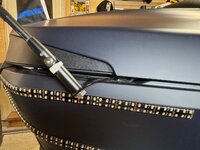If you only '
checked' your fuel consumption by reading the SWAG indication on the dash, then
it's way too short of a ride to be truly considered valid, but it's a nice indicator of what your MPG
might be when you check it properly by calculating the volume of fuel used in multiple fuel tank fills over a distance of
at least a few hundred if not a few thousand miles.

But if you actually
did check it by calculating the volume of fuel used in multiple fuel tank fills over a considerable distance, but your Spyder has only done 800 miles total rather than saaayyy, 5,000;
then not only do you still have at least a few thousand miles of skills fine-tuning to come, but it's STILL way too short of a ride to be truly considered valid, altho it
is a nice indicator of what your MPG
might become eventually when you do have those skills dialled in and you check it properly.

However, it is very likely that your Spyder
IS a little bit more '
Run in' (I really hope it's
NOT 'broken in'!!

) and all the '
tightly fitted on manufacture' internal things (please excuse the highly technical term used there, for those specialised parts!

) are beginning to bed in properly and so move a little bit better; AND highly likely that you're getting better at hitting the ideal shift points yourself/by feel/ear, even if aided in that by reducing the sensitivity of the throttle somewhat thru the use of ECO Mode.

Only if your experience with this ECO Mode is anything like that of most who try it, then move on; while ECO Mode can help you initially to get a feel for &/or better at hitting the shift points, it's not really all that great a tool/aid, as all it really does is retard the throttle sensitivity so that you will never hit/get near WOT; and in time, most who have the self control to avoid wringing their engine's neck at every opportunity do generally get somewhat if not significantly better milage in due course by
AVOIDING using ECO Mode entirely!

But the SWAG indicator on the dash will never be anything but a SWAG, and not really ever a 'truly valid' indicator of your fuel consumption... But if you want to use it to confirm to yourself that you weren't being quite so much of a hooligan on your last ride/single tank full of gas, then it can do that well - just don't kid yourself that the number shown is going to really reflect an accurate calculation of fuel usage volume &/or distance travelled, cos it's basically an average of a bunch of instantaneous readings taken over who knows what time/operational parameters and there's even more 'woolly variables' built into your Spyder and its set-up of many things including saaay, its fuel delivery system; the tire size & yhe specified revs per mile they run; the air pressure in said tires & the impact that has on your distance travelled accuracy; and all sorts of other things. Sure, it could be good if all of those variables were identified &/or controlled/used in the calculations, but they're not, so you'll still get a much more accurate calculation derived from your odo/trip meter (or better yet, a GPS derived) 'Distance Travelled' and the vaguely calibrated fuel volume delivered from a variety of gas station pumps and running an ongoing calculation over months and miles - the longer the distance/greater the numbers of tanks full, the more realistic your results are going to be!

Just Sayin'





